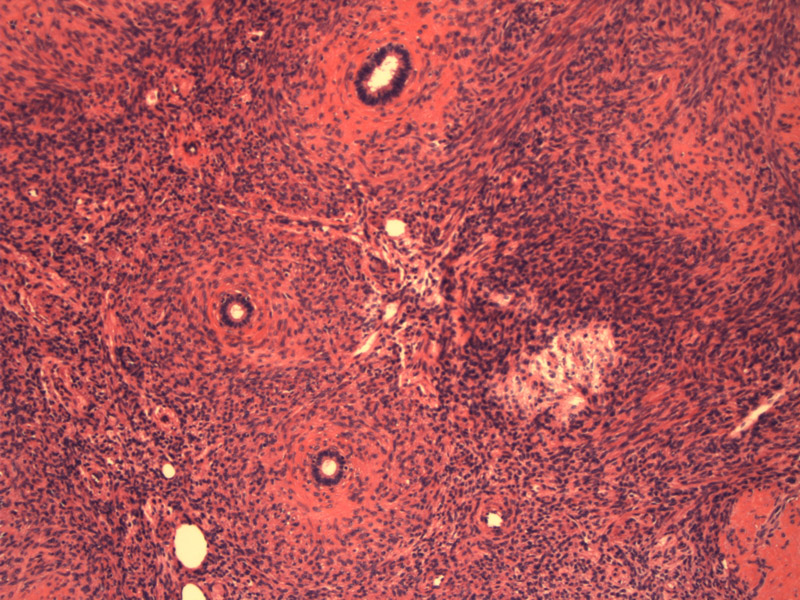

Tubular glands are surrounded by stromal containing smooth muscle and fibrous tissue. In this particular case, it is difficult to tell if the glands are endocervical-type or endometrial-type. Cytologically, they appear endometrial, however there is no rim of endometrial stroma typically seen in endometrial-type adenomyomas. To complicate the picture, endocervical-type adenomyomas may occasionally have tubal-type or endometrioid-type epithelium. Either way, subclassifying adenomyomas into endometrial or endocervical types is largely an academic exercise as both lesions are benign.
Irregularly-shaped glands are surrounded by swirls of smooth muscle. A cystically dilated gland (left center) and a compressed gland (right center) are seen.
The gland appears to be lined by tubal-type epithelium (note the cilia). The stroma of the adenomyoma blends in imperceptibly with the surrounding myometrium.
Adenomyomas are biphasic tumors composed of glands and smooth muscle. These are two variants of adenomymomas: endocervical-type and endometrioid-type.
Endocervical-type adenomyomas consist of endocervical glands surrounded by smooth muscle and fibrous tissue. These polypoid masses typically arise from the cervix or lower uterine segment and are often mistaken for endocervical polyps.1 However, unlike endocervical polyps, the stromal component is predominately composed of smooth muscle fascicles. The main differential diagnosis, however, is to distinguish this benign entity from adenoma malignum.
In both adenoma malignum and adenomyoma, bland appearing endocervical glands with irregular contours are surrounded by a spindled stroma containing fascicles of smooth muscle. However, in endocervical-type adenomyoma, the glands tend to have a lobulated architecture, with smaller glands encircling larger dilated glands. In adenoma malignum, the glands are haphazardly arranged and have an infiltrative appearance. Furthermore, in adenoma malignum, there should be focal cytologic atypia and stromal desmoplasia.
Endometrioid-type adenomyomas consist of endometrial glands lined by a rim of endometrial stroma. The glands are embedded by fascicles of smooth muscle and fibrous tissue. Some authors wonder if they may represent circumscribed version of adenomyosis.2 As opposed to atypical polypoid adenomyoma (APA), the endometrial glands do not exhibit atypia. In APA, one usually finds the distinctive squamous morules within or replacing the glands.
Typically occur in reproductive age women. Symptoms depend on size and location and could include pain and vaginal bleeding.
Treatment is dependant on the degree of bother and type of symptoms. It may involve excision or even hysterectomy for definitive therapy.
Excellent; lesion is benign. May recur if excision is not complete or occur as a new separate lesion.
• Endometrium : Atypical Polypoid Adenomyoma
1 Nucci MR, Oliva Esther. Gynecologic Pathology: Foundations in Diagnostic Pathology. Philadelphia, PA: Elsevier: 2009: 319-321.
2 Fletcher CDM, ed. Diagnostic Histopathology of Tumors. 3rd Ed. Philadelphia, PA: Elsevier; 2007: 687-8.